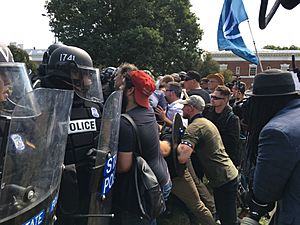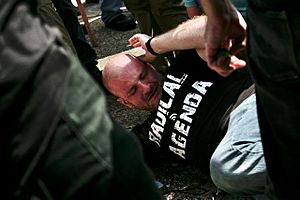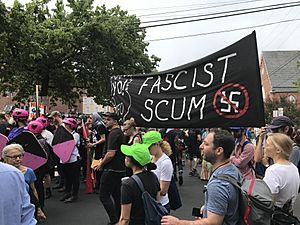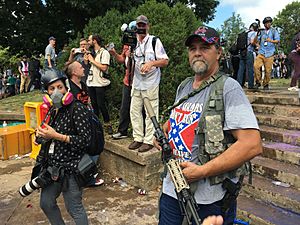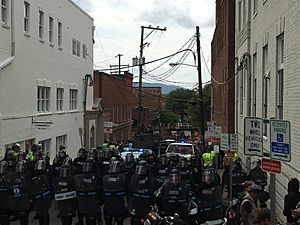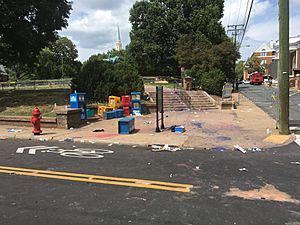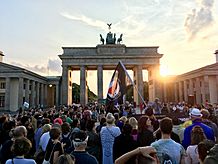Unite the Right rally facts for kids
| Part of Antisemitism in the United States and neo-Nazism in the United States | |

Rally participants preparing to enter Lee Park in Charlottesville, Virginia, on August 12, 2017, carrying Neo-Confederate flags, Confederate battle flags, Gadsden flags, a Nazi flag, and a flag depicting Mjölnir
|
|
| Date | August 11–12, 2017 |
|---|---|
| Location | Charlottesville, Virginia, U.S. |
| Theme |
|
| Organized by | Jason Kessler, Richard Spencer |
| Participants | Various alt-right, neo-Nazi, neo-fascist, white supremacist, white nationalist, Ku Klux Klan, neo-Confederate, Identitarian and other far-right groups |
| Casualties | |
|
|
| Arrests | 11 |
The Unite the Right rally was a gathering of white supremacist groups in Charlottesville, Virginia. It took place on August 11 and 12, 2017. People at the rally included members of groups like the alt-right, neo-Nazis, and the Ku Klux Klan. Some chanted racist and antisemitic (anti-Jewish) slogans. They also carried weapons and symbols like Nazi flags and Confederate battle flags.
The main reasons for the rally were to unite different white nationalist groups. They also wanted to protest the planned removal of a statue of General Robert E. Lee from a local park. This event led to a big discussion across the country about Confederate symbols, racial violence, and white supremacy.
The rally happened because many local governments were removing Confederate monuments. This started after a white supremacist shot and killed nine Black church members in 2015. The Charlottesville rally became violent when protesters fought with counter-protesters. More than 30 people were hurt.
On August 12, the governor of Virginia, Terry McAuliffe, declared a state of emergency. This meant he needed more power to keep people safe. Soon after, the Virginia State Police said the rally was an unlawful assembly and ordered people to leave. Later that day, a white supremacist named James Alex Fields Jr. drove his car into a crowd of counter-protesters. This attack killed Heather Heyer and injured 35 others. Fields was arrested and later found guilty of murder and other crimes.
U.S. President Donald Trump's comments about the rally caused a lot of debate. He said there was "hatred, bigotry, and violence on many sides." Many people criticized this, saying it made the white supremacists seem equal to those protesting against them. Trump later said he was not talking about neo-Nazis and white nationalists, who "should be condemned totally."
After the rally, there was a strong reaction against white supremacist groups. Many of their events were canceled, and their online accounts were closed. People also used social media to identify and publicly shame marchers. This led to some attendees losing their jobs. The rally was meant to unite far-right groups, but it actually caused problems and arguments among their leaders. This led to a decline in the movement.
A year later, on August 11–12, 2018, another rally called "Unite the Right 2" was held in Washington, D.C.. This time, only a few dozen protesters showed up, while thousands of counter-protesters gathered.
Contents
- Why the Rally Happened
- What Happened During the Rally
- Important Events After the Rally
- Reactions to the Rally
- Consequences of the Rally
- 2018 Anniversary Rally
- Legacy of the Rally
- See also
Why the Rally Happened
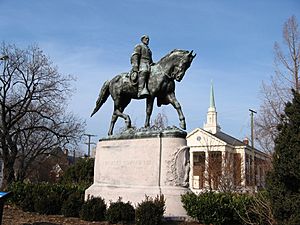
After a shooting in June 2015, many places in the South started to remove Confederate statues and rename streets. This was often successful, but some people who wanted to protect their Confederate history were upset. The Unite the Right rally was organized by Jason Kessler, a white supremacist from Charlottesville. He wanted to protest the city's decision to remove the Robert E. Lee statue and rename the park it was in.
Kessler started protesting in March 2016 when a city official called for the statue's removal. Kessler said this was an attack on "white history." The park became a place for many neo-Confederate events in 2017. This made the public space even more political.
Rallies in Charlottesville During Summer 2017
On May 13, 2017, Richard Spencer, a white supremacist leader, led a nighttime rally in Charlottesville. Over 100 protesters chanted anti-Jewish slogans and held lit torches near the statue. Many residents found this scary, and the mayor said it reminded him of the KKK. The next night, hundreds of anti-racist residents held a peaceful counterprotest.
Throughout 2017, tensions grew as white supremacist groups gathered in Charlottesville. They were often met by anti-racist activists, leading to small fights and arrests. On July 8, 2017, the Loyal White Knights of the Ku Klux Klan held a rally. About 50 Klan members were met by 1,000 counter-protesters. Police later used tear gas on some retreating counter-protesters, which caused mistrust between law enforcement and activists. This set the stage for the August 12 rally.
Who Were the Protesters?
Many far-right groups helped organize the march. These included groups like The Daily Stormer, The Right Stuff, and the National Policy Institute. Other groups involved were the Ku Klux Klan, Identity Evropa, and the Rise Above Movement.
Many well-known far-right figures attended. These included Richard Spencer, David Duke (a former Ku Klux Klan leader), and Jason Kessler, the rally organizer.
Who Were the Counter-Protesters?
People who protested against the rally were united in opposing white supremacy. Many were regular Charlottesville residents who disliked the white supremacist groups. Before the rally, many faith-based groups, civil rights organizations, and students planned counterprotests. Groups like Black Lives Matter, Anti-Racist Action, and the Democratic Socialists of America were present. Some members of the antifa movement also attended. Some counter-protesters were armed.
City and University Get Ready
The rally was scheduled between school terms at the University of Virginia (UVA). The university president told students to avoid the rally because of a "credible risk of violence." The UVA Medical Center canceled surgeries and prepared for emergencies. Some downtown businesses closed, fearing violence.
State officials suggested banning weapons and blocking traffic. However, the city did not put these rules in place. City officials said their local laws made it hard to follow all the state's suggestions.
What Happened During the Rally
Permits and Court Case
Jason Kessler, the organizer, asked the City of Charlottesville for a permit to hold the event at Lee Park. The city wanted to move the rally to a larger park, McIntire Park, because of safety concerns. Kessler refused to move it.
Kessler, with help from the ACLU, sued the city. On the night before the rally, a judge ruled that the rally could happen at Lee Park as planned. The judge said the statue was the main reason for the rally. He also noted that moving it might be based on the organizers' views, not just safety. The ACLU praised this decision.
After the rally, the ACLU said it would no longer defend hate groups protesting with firearms.
Events on August 11
On Friday evening, August 11, a group of white nationalists marched through the University of Virginia campus. They chanted Nazi and white supremacist slogans like "Jews will not replace us." Many carried lit tiki torches.
At a statue of Thomas Jefferson, they met about 30 counter-protesters, mostly students. A fight broke out. People were hit with pepper spray, and some had minor injuries. The white nationalists swung their lit torches. Police arrived several minutes later to break up the fight.
The university president later said she didn't know about the torch march beforehand. However, reports showed that university police had been in contact with one of the group's leaders about the march route.
Events on August 12
Protesters and counter-protesters started gathering early on Saturday, August 12. White nationalist protesters again chanted hateful slogans. Some waved Confederate flags and signs targeting Jewish people. Many wore "Make America Great Again" hats.
Jewish worshippers at a nearby synagogue, Beth Israel, had to leave through a back door. They carried their holy Torah scrolls for safety. This was because men with rifles were across the street, and Nazi websites had called for burning their building.
Counter-protests began with a group of religious leaders holding hands and singing songs of peace. Later, counter-protesters chanted slogans like "Kill All Nazis." Some armed leftist groups were also present. A Harvard professor, Cornel West, said that if it weren't for anti-fascist groups, the counter-protesters "would have been crushed like cockroaches." He also noted that police "pulled back."
Virginia law allows people to open carry firearms. Many people on both sides were armed, some with semi-automatic weapons. This made it hard for the police. Many also carried shields, sticks, and helmets. During the rally, a Ku Klux Klan leader, Richard W. Preston, shot a pistol at a Black counter-protester. Preston was found guilty of firing a weapon near a school.
Fights started before the rally officially began. People threw punches, screamed, and used chemical sprays. About 500 protesters and over a thousand counter-protesters were there. At least 14 people were hurt in street fights. Several people were arrested for assault.
At 11:00 a.m., Charlottesville declared a state of emergency. An hour later, Governor McAuliffe also declared a state of emergency. He said protesters, mostly from outside the state, were endangering citizens. At 11:22 a.m., the Virginia State Police declared the gathering an unlawful assembly. They used megaphones to tell people to leave. Riot police then cleared the area.
Important Events After the Rally
Car Attack and Death
What Happened
After the rally was stopped, around 1:45 p.m., James Alex Fields Jr. drove his car into a crowd of counter-protesters. He hit several people and crashed into other cars, pushing them into the crowd. One person was killed, and 35 others were injured. Police said the attack was deliberate.
The crash happened on a pedestrian street. Heather Heyer, a 32-year-old paralegal from Charlottesville, was killed. She died at the hospital. Videos showed Fields' car speeding into the crowd. Witnesses said it was a "violent attack." Five people were in critical condition at first.
About Heather Heyer
Heather Danielle Heyer (born May 29, 1985; died August 12, 2017) was the only person killed in the attack. She worked as a paralegal and also as a bartender. Heyer had planned not to protest because it seemed too dangerous. But the night before, she felt she had to go.
Heather's mother, Susan Bro, said she wanted Heather's name to be a "rallying cry for justice and equality." Her memorial service was held on August 16. Her mother asked mourners to honor Heather by fighting injustice.
Arrest and Conviction of James Alex Fields Jr.
Soon after the crash, James Alex Fields Jr., 20, from Ohio, was arrested. He was charged with second-degree murder. Fields had been seen at the rally holding a shield with a white supremacist group's logo. The group later said he was not a member. Fields was denied bail and held in jail.
Many officials, including the U.S. Attorney General, called the attack an act of domestic terrorism. The U.S. Department of Justice started a civil rights investigation.
Fields was later charged with first-degree murder and other crimes. During his trial, he claimed he acted out of fear. However, videos and witnesses showed he was not under attack when he drove into the crowd. Evidence also included a text message where Fields sent a picture of Adolf Hitler to his mother. He also called Heather Heyer's mother "a communist" from jail.
On December 7, 2018, Fields was found guilty of first-degree murder and nine other charges. The jury recommended a sentence of life in prison plus 419 years. The judge accepted this recommendation. In March 2019, Fields pleaded guilty to 29 federal hate crimes. This was part of a deal to avoid the death penalty. He was sentenced to life in prison for the federal charges in June 2019.
Assault on DeAndre Harris
DeAndre Harris, a 20-year-old Black man, was badly beaten in a parking garage. This attack was caught on video and in photos. Police investigated, and four men were arrested and charged with malicious wounding. Two of them, Alex Michael Ramos and Jacob Scott Goodwin, were found guilty and sentenced to prison. Daniel Borden and Tyler Watkins Davis also received jail time.
Harris himself was charged with assault after a white supremacist claimed Harris attacked him. However, a judge later found Harris not guilty. The judge said Harris believed the white supremacist was attacking his friend and acted in defense.
Helicopter Crash
Around 4:40 p.m. on August 12, a Virginia State Police helicopter crashed. It was on its way to help with security. Two state troopers, Lieutenant H. Jay Cullen and Trooper-Pilot Berke M. M. Bates, were killed. An investigation later found that the helicopter crashed because the pilot lost control.
Reactions to the Rally
Criticism of Police Handling
After the rally, many people criticized how the police handled it. The City of Charlottesville hired Timothy J. Heaphy, a former U.S. Attorney, to review the events.
The final report, released in December 2017, strongly criticized the city's actions. It found that the Charlottesville Police Department was not ready for the events. Their plan was flawed, and officers were not properly trained. The report also criticized the city council, state police, and the University of Virginia. It said law enforcement failed to stop fights and put officer safety above public safety.
Responses from Rally Organizers
On August 13, rally organizer Jason Kessler tried to hold a press conference. But an angry crowd attacked him, and police had to escort him away. People shouted "shame" at Kessler and called out Heather Heyer's name. Kessler said he was against political violence and blamed the city for what happened.
Former Ku Klux Klan leader David Duke said the protests were a "turning point" for white Americans. Richard Spencer, another organizer, blamed counter-protesters and police for the violence.
Vigils and Protests
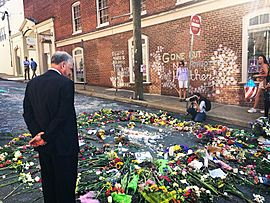
The day after the rally, many groups held vigils and demonstrations across the country and even abroad. They wanted to show support against white supremacy, remove Confederate monuments, and speak out against fascism.
In cities like Brooklyn and Los Angeles, hundreds gathered to condemn the violence. Thousands of anti-Trump protesters marched around Trump Tower.
Online Reactions
Online companies took action against white supremacist groups. GoDaddy and Google Domains removed The Daily Stormer website for violating their rules. PayPal also closed accounts used by rally organizers because they promoted hate and violence.
The hacktivist group Anonymous shut down many websites linked to the Ku Klux Klan and neo-Nazi groups.
On Twitter, users identified white nationalist marchers from photos. This led to some people losing their jobs. However, there was at least one case of mistaken identity, where an innocent professor was wrongly accused.
President Trump's Response
First Statements
President Trump first commented on the rally on August 12. He tweeted that "we ALL must be united & condemn all that hate stands for." Later, he said he condemned the "hatred, bigotry, and violence on many sides, on many sides." He added that this had been "going on for a long time."
Many people criticized Trump's "many sides" comment. They said it was too vague and didn't specifically condemn white supremacists. The New York Times noted that Trump was the only national leader to spread blame to "many sides." Many politicians, including Republicans, called on Trump to specifically name and condemn white nationalists. Former Ku Klux Klan leader David Duke thanked Trump for his "honesty."
Second Statement
After the criticism, Trump read a new statement two days later. He said that "racism is evil" and condemned the "K.K.K., neo-Nazis, white supremacists and other hate groups." He said these groups were "repugnant to everything we hold dear as Americans."
Trump reportedly did not want to make this statement, but his chief of staff convinced him.
Third Statement
On August 15, Trump again spoke to reporters. He defended his first statement and repeated that there was "blame on both sides." He said, "Not all of those people were neo-Nazis, believe me. Not all of those people were white supremacists by any stretch." He added that there were "very fine people on both sides." Trump also said that removing Confederate statues was "changing history."
Trump also said that counter-demonstrators did not have a permit, which was false.
Reactions to Third Statement
Many politicians, both Democrats and Republicans, condemned Trump's third statement. Speaker of the House Paul Ryan said, "White supremacy is repulsive. This bigotry is counter to all this country stands for. There can be no moral ambiguity." Former presidents George H. W. Bush and George W. Bush also said that "America must always reject racial bigotry, anti-Semitism, and hatred in all forms."
The fallout led to calls for Trump to resign or be removed from office. Heather Heyer's mother, Susan Bro, said she would not meet with Trump after his comments.
Resignations from Presidential Councils
Several business leaders resigned from President Trump's advisory councils. They did this because of his response to the rally. For example, Kenneth Frazier, the CEO of Merck, resigned. Other CEOs from companies like Under Armour and Intel also left.
On August 16, Trump dissolved both councils after members started to leave. Later, 16 of 17 members of the President's Committee on the Arts and Humanities resigned in protest. They said Trump's support of hate groups was unacceptable.
Defenses of Trump
Some conservative commentators argued that Trump was unfairly criticized. They said the media ignored violence from antifa activists. However, others argued that antifa's actions did not make white supremacists morally equal. They pointed out that white supremacists promote ideologies like ethnic cleansing and genocide.
Historians noted that unlike Confederate figures, American founders like George Washington and Thomas Jefferson are important for creating the United States. Confederate figures fought against the U.S. to defend slavery.
Responses from Other Politicians
The day after the rally, Virginia Governor McAuliffe told white supremacists to "Go home." He said, "You are not wanted in this great commonwealth." Charlottesville Mayor Michael Signer also blamed Trump for increasing racial tensions.
German Chancellor Angela Merkel called the violence "horrifying" and "evil." She said strong action must be taken against racist violence. The Republican National Committee also condemned the white supremacist demonstration.
Former Vice President Joe Biden launched his 2020 presidential campaign with a video condemning the Charlottesville events. He said Trump's words created a "moral equivalence" between hate groups and those who stood against them.
Religious Responses
Many religious organizations condemned the rally. The World Council of Churches said violence against peaceful people seeking justice must be condemned. Major Christian denominations, including the Presbyterian Church (U.S.A.) and the United Methodist Church, spoke out. Jewish organizations also strongly condemned the white supremacist violence.
Consequences of the Rally
Financial Costs
The rally cost Charlottesville and surrounding areas about $540,000. This included police overtime, fire department costs, and legal fees.
Removal of Statues
The violence in Charlottesville sped up the removal of public Confederate statues across the U.S. About twenty monuments were removed in the weeks after the rally. In Baltimore, four Confederate statues were removed overnight. Statues were also removed from the University of Texas at Austin.
A plaque in Montreal honoring Jefferson Davis was also removed after many complaints. On July 10, 2021, Charlottesville finally removed the statues of General Lee and Stonewall Jackson.
Local Politics
Most senior city officials in Charlottesville resigned or retired within a year of the rally. This included the city attorney, police chief, and city manager.
The rally also led to a left-wing political group gaining power in local politics. Their goal was to fix old racial and economic problems. Nikuyah Walker, an activist who confronted city leaders after the rally, was elected mayor in January 2018.
Sines v. Kessler Lawsuit
In November 2017, nine Charlottesville residents sued Jason Kessler and other rally organizers. They claimed their civil rights were violated because organizers encouraged violence. The plaintiffs sought money for their injuries and to stop future violent acts.
The trial began in October 2021. In November 2021, a jury found 17 white nationalist leaders and groups responsible. They were ordered to pay more than $25 million in damages.
Arrests of "Rise Above Movement" Members
In August 2018, four members of the Rise Above Movement (RAM), a white supremacist gang, were charged in federal court. They were accused of planning violence at the rally and attacking counter-protesters. These men pleaded guilty in May 2019 and received prison sentences.
The founder of RAM, Robert Rundo, was also charged. He fled the country but was arrested and brought back to the U.S.
Threats Against a Local Politician
Don Gathers, a Black community activist in Charlottesville, planned to run for city council in 2019. He was also a member of the Civilian Police Review Board. However, he withdrew from the race and resigned from the board.
In September 2019, a white supremacist named Daniel McMahon was arrested. He was charged with threatening Gathers because he was a Black man running for office. McMahon had praised James Alex Fields Jr. and other violent figures online.
2018 Anniversary Rally

In November 2017, Jason Kessler applied for a permit to hold another rally in Charlottesville in August 2018. The city denied the permit, saying it couldn't guarantee safety.
In June 2018, Kessler's request for a "White Civil Rights Rally" was approved for Washington D.C. A group of activist organizations planned a large counter-protest.
On August 12, 2018, the Unite the Right 2 rally happened. Only about 30 Kessler supporters showed up, while thousands of counter-protesters gathered. There were few arrests, no injuries, and a rainstorm ended the event early.
Legacy of the Rally
In August 2018, NPR noted that "Charlottesville has become shorthand for racial strife." It also said the rally made the town rethink its racial history.
A political scientist, Cas Mudde, wrote that the rally was not a success for the alt-right. He said it failed to show the alt-right was a major force or unite different far-right groups.
On the third anniversary of the rally in August 2020, experts said that the violence and hatred seen in Charlottesville was not a one-time event. They pointed to later killings and shootings that echoed the ideas from the rally.
January 6 United States Capitol Attack
Experts say that key figures from the Unite the Right rally helped create online anger before the January 6 United States Capitol attack.
See also
 In Spanish: Manifestación Unite the Right para niños
In Spanish: Manifestación Unite the Right para niños
- List of incidents of civil unrest in the United States
- 1939 Nazi rally at Madison Square Garden
- 2017 Berkeley protests
- Boston Free Speech Rally
- Liberation and Freedom Day, a new holiday in Charlottesville
- 2020 VCDL Lobby Day
- 2021 United States Capitol attack
- "Documenting Hate, Charlottesville"
- Robert Edward Lee (sculpture) § Protests against its removal
- Matthew Q. Gebert, US State Department employee who attended the rally
- Patriot Front, an alt-right group formed after the rally
- Bitburg controversy


